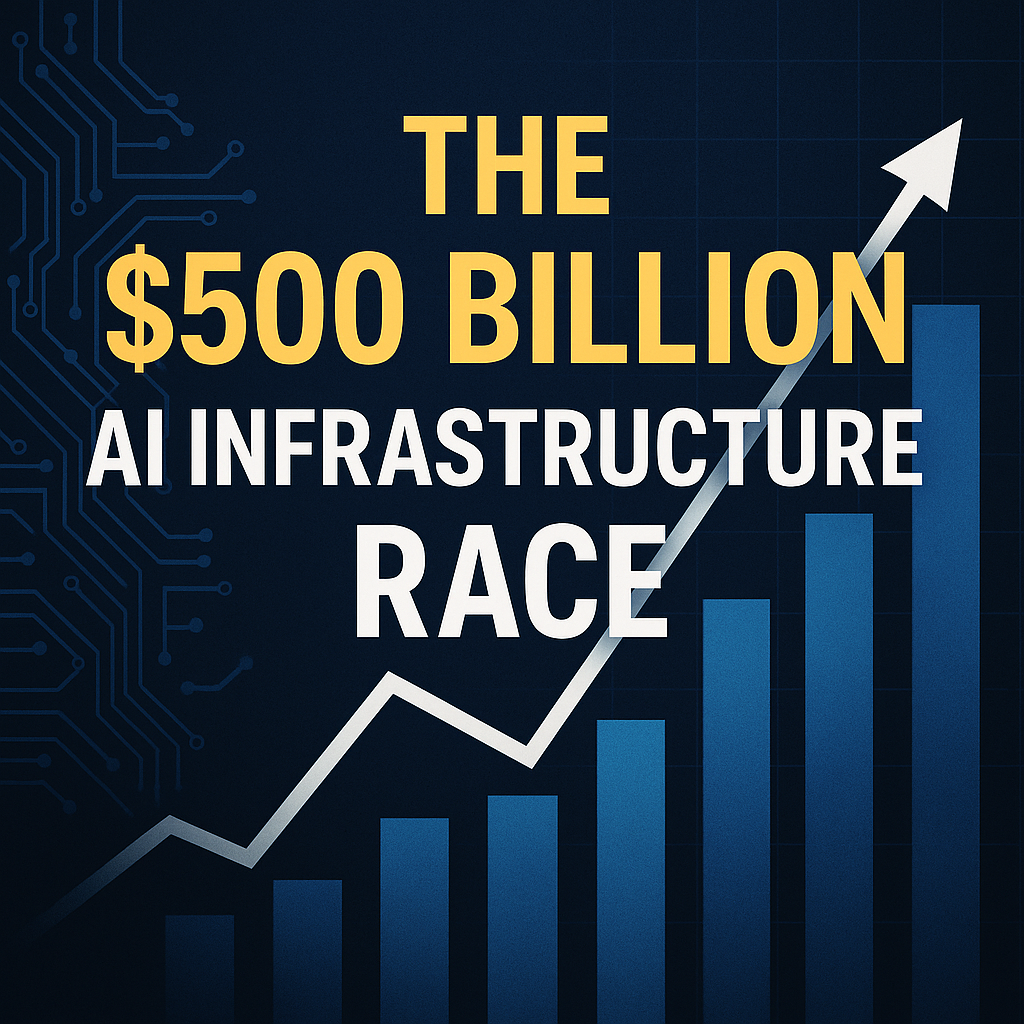The $500 Billion AI Infrastructure Race
The artificial intelligence revolution isn’t just changing software, it’s fundamentally rewiring the physical infrastructure of the digital age. We’re witnessing the largest capital expenditure cycle in technology history, one that’s growing twice as fast as Moore’s Law ever predicted and demanding $500 billion annually just to keep pace. This isn’t your typical tech boom; it’s an infrastructure revolution that’s testing the very limits of physics, power grids, and corporate balance sheets.
The Numbers That Define a Revolution
The scale of AI infrastructure investment defies comprehension. In 2024, the global artificial intelligence market reached $279.22 billion, but it’s projected to explode to $3.5 trillion by 2033, a staggering compound annual growth rate of 31.5%. Meanwhile, hyperscale companies alone are spending close to $400 billion annually on AI infrastructure, with the “Big Four” hyperscalers (Amazon, Microsoft, Google, and Meta) set to invest a combined $315 billion by 2025.
To put this in perspective, that’s more than the GDP of Finland and nearly matches ExxonMobil’s entire 2024 revenue. Even more remarkably, AI capital expenditure has contributed more to GDP growth than consumer spending in 2025, despite representing only 6% of the economy.
The transformation has been swift and decisive. Just ten years ago, these same companies invested a modest $23.8 billion in data centre infrastructure. By 2025, that figure will reach $315 billion—a thirteen-fold increase that makes the cloud computing boom look positively restrained.
Why Moore’s Law Couldn’t Keep Up
Gordon Moore’s famous observation that computing power doubles every two years has guided the semiconductor industry for over half a century. But artificial intelligence has shattered this predictable progression. AI model complexity has been doubling 20 times per year, utterly eclipsing Moore’s Law’s modest doubling every 24 months.
NVIDIA’s CEO Jensen Huang has coined the term “Hyper Moore’s Law” to describe this phenomenon, suggesting AI computing performance could double or triple annually rather than biennially. This isn’t just theoretical, it’s playing out in real time as AI workloads demand computational resources that would have seemed impossible just a few years ago.
The physical demands are staggering. Training a single large language model now requires tens of thousands of GPUs operating continuously, with future models potentially needing “one to several gigawatts of power”, equivalent to dedicating an entire power plant to a single AI system.
The Physics Problem: Power, Heat, and Reality
The infrastructure challenges extend far beyond computing power. Modern AI chips are power-hungry beasts that push the boundaries of what data centres can handle. NVIDIA’s H100 GPU, the workhorse of AI training, consumes 700 watts—nearly ten times more than a traditional CPU. Its successor, the B200, demands a whopping 1,000 watts, with some configurations reaching 1,200 watts.
This represents a 300% increase in power consumption across just one generation of AI chips. While each generation becomes more efficient per calculation, the sheer scale of AI workloads means total energy consumption continues to climb exponentially.
The power grid implications are profound. Data centres now consume 3-4% of U.S. electricity, but this could reach 8-12% by 2030. An estimated 35 gigawatts of additional capacity will be needed within five years, but at current transmission infrastructure build-out rates, it could take 80 years to meet this demand.
AI workloads also create unprecedented power fluctuation challenges. Unlike traditional computing, AI training can swing from 90% to 30% power consumption within minutes as GPU clusters cycle between computation and communication phases. At gigawatt scale, these fluctuations risk destabilising entire power grids.
The £6.7 Trillion Infrastructure Gap
McKinsey’s analysis reveals the stark arithmetic of AI’s infrastructure demands: by 2030, data centres worldwide will require $6.7 trillion in investment to keep pace with compute power demand. This figure assumes AI applications deliver genuine business value, if they don’t, we could see the largest stranded asset write-offs in corporate history.
The challenge is particularly acute in the UK, where industrial electricity prices are four times higher than the US and 46% above the international median. Grid connection times stretch over a decade, and the connections queue extends to 771 gigawatts, more than seven times current total UK generating capacity.
The UK government has acknowledged this challenge, projecting the country will need at least 6 gigawatts of AI compute capacity by 2030, approximately a quarter of the nation’s projected electricity generation. This has prompted proposals for AI Growth Zones and accelerated planning reforms to unlock the infrastructure investment needed to remain competitive.
The Stargate Gambit: A $500 Billion Bet
The most audacious infrastructure commitment comes from the Stargate Project, announced by OpenAI, Oracle, and SoftBank in January 2025. This $500 billion initiative over four years represents private sector confidence on an unprecedented scale, with an immediate deployment of $100 billion.
Early progress has been remarkable. By September 2025, Stargate had already secured nearly 7 gigawatts of planned capacity and over $400 billion in investment, putting the project ahead of schedule to reach its full 10-gigawatt commitment by year-end. The scale is breathtaking: individual data centres spanning half a million square feet, each requiring dedicated power infrastructure equivalent to a small city.
The Valuation Paradox: Growing Into Their Worth
Despite the massive capital deployment and infrastructure spending, market valuations suggest this isn’t a speculative bubble. The forward price-to-earnings ratio for the S&P 500 sits around 21, elevated compared to the historical average of 15-16, but nowhere near the dot-com peak of 34.
More tellingly, the “Magnificent Seven” AI companies trade at a forward P/E of roughly 40x, but excluding Tesla’s outlier 100x+ multiple, the rest average mid-20x P/E, well below the 1000x+ ratios common during the dot-com bubble.
The companies driving AI infrastructure investment also demonstrate fundamental financial strength that was absent in 2000. They generate substantial profits, maintain strong balance sheets, and show consistent revenue growth. Unlike dot-com darlings that burned through cash with little to show for it, today’s AI leaders are investing massive capital from position of financial strength rather than desperation.
The Economics of Transformation
AI’s economic impact extends far beyond the companies building the infrastructure. The technology is becoming embedded across industries, from healthcare and finance to manufacturing and retail. A recent survey found that 78% of organisations reported using AI in 2024, up from 55% the year before.
This broad adoption creates a virtuous cycle: as AI becomes more useful, demand for compute power increases, justifying further infrastructure investment. The challenge lies in ensuring this cycle remains economically sustainable.
Bain & Company estimates that by 2030, companies will need to generate $2 trillion in annual revenue to justify the projected $500 billion in annual capital expenditure. That’s $800 billion more than current estimates suggest AI can save through efficiency improvements alone, meaning new products and services must emerge to close the gap.
The Geopolitical Stakes
The AI infrastructure race has become a matter of national competitiveness and security. Countries are recognising that AI capability depends as much on physical infrastructure as software innovation. The U.S. Stargate project explicitly positions itself as securing “American leadership in AI” and providing “strategic capability to protect national security”.
China has responded with its own infrastructure investments, while European nations grapple with higher energy costs and regulatory constraints that make large-scale AI data centre development more challenging. The UK’s AI Growth Zone strategy represents an attempt to remain competitive despite these structural disadvantages.
The Environmental Reckoning
The environmental implications of AI’s infrastructure boom cannot be ignored. Each new generation of AI chips consumes dramatically more power while generating proportionally more heat. A single ChatGPT query uses nearly ten times the electricity of a Google search, and this differential will only widen as AI capabilities expand.
Data centre operators are scrambling to develop sustainable solutions, from advanced cooling systems to on-site renewable energy generation. Some are exploring fuel cells and other distributed power sources to reduce grid strain and provide more reliable power for AI workloads.
What Happens Next?
We stand at an inflection point. The next 18 months will determine whether the massive AI infrastructure investments prove prescient or premature. Early signs are encouraging: enterprise AI adoption is accelerating, new applications are emerging regularly, and the technology is beginning to demonstrate clear productivity gains.
However, the scale of investment means the margin for error is thin. If AI applications fail to generate sufficient economic value, we could see a correction that makes the dot-com crash look modest. Conversely, if AI delivers on its transformative promise, the companies and countries that built the infrastructure foundation will reap outsized rewards for decades.
The AI infrastructure boom represents more than a technology investment, it’s a bet on a fundamentally different future. Unlike previous technology waves that primarily shifted existing activities online, AI promises to augment human capability in ways we’re only beginning to understand.
The $500 billion question isn’t whether AI will transform society, that’s already happening. It’s whether the massive infrastructure investments being made today will prove sufficient for the AI-powered world taking shape around us. Given the exponential growth in AI capability and adoption, the safe bet may be that even these record-breaking investments will seem conservative in hindsight.
The gold rush analogy is apt, but perhaps incomplete. This isn’t just about extracting value from a finite resource, it’s about building the infrastructure for an entirely new form of digital civilisation. Those who adapt early and invest wisely in this infrastructure revolution won’t just own the next decade; they’ll define it.
Sources
- https://www.grandviewresearch.com/industry-analysis/artificial-intelligence-ai-market
- https://openai.com/index/announcing-the-stargate-project/
- https://www.bbc.co.uk/news/articles/cy4m84d2xz2o
- https://www.mckinsey.com/industries/technology-media-and-telecommunications/our-insights/the-cost-of-compute-a-7-trillion-dollar-race-to-scale-data-centers
- https://explodingtopics.com/blog/ai-statistics
- https://bits-chips.com/article/ai-surge-demands-that-moores-law-transcends-itself/
- https://www.asml.com/technology/all-about-microchips/moores-law
- https://www.clarifai.com/blog/nvidia-b200-vs-h100
- https://www.tweaktown.com/news/97059/nvidias-full-spec-blackwell-b200-ai-gpu-uses-1200w-of-power-up-from-700w-on-hopper-h100/index.html
- https://www.datacenterfrontier.com/sponsored/article/55267948/ai-and-data-center-energy-demands-are-fuel-cells-the-answer
- https://www.io-fund.com/artificial-intelligence/ai-platforms/ai-power-consumption-becoming-mission-critical
- https://semianalysis.com/2025/06/25/ai-training-load-fluctuations-at-gigawatt-scale-risk-of-power-grid-blackout/
- https://dcpulse.com/statistic/the-great-ai-infrastructure-race-hyperscaler-capex
- https://fortune.com/2025/10/07/ai-bubble-cisco-moment-dotcom-crash-nvidia-jensen-huang-top-analyst/
- https://fortune.com/2025/10/03/ai-bubble-tech-stocks-price-earnings-ratio-dot-com-boom-bust/
- https://www.foxbusiness.com/economy/ai-stock-euphoria-this-another-2000-dot-com-bust-in-the-making
- https://www.janushenderson.com/corporate/article/are-tech-sector-investors-too-bullish-on-ais-promise/
- https://www.mckinsey.com/capabilities/mckinsey-digital/our-insights/the-top-trends-in-tech
- https://www.pwc.com/us/en/tech-effect/ai-analytics/ai-predictions.html
- https://hai.stanford.edu/ai-index/2025-ai-index-report
- https://www.businessinsider.com/big-tech-ai-capex-infrastructure-data-center-wars-2025-10
- https://uk.investing.com/analysis/why-the-ai-boom-may-defy-history-4-reasons-this-time-could-be-different-200619179
- https://www.nvidia.com/en-gb/data-center/dgx-b200/
- https://www.pwc.co.uk/industries/insights/transforming-infrastructure-investment-private-funding-perspective.html
- https://institute.global/insights/tech-and-digitalisation/sovereignty-security-scale-a-uk-strategy-for-ai-infrastructure

